
Breathe Life into Your Games
In the last chapter I used the analogy of anatomy to describe the component parts of a game. That discussion hopefully helps us think of games experiences as living things and I believe as designers it’s our job to breathe life into play. In this chapter I want us to take this analogy further and make the hypothesis that, for the player, their game will go through a lifecycle and that understanding this lifecycle is a defining skill that separates successful games as a service design from box-products. Lifetime value is critical to success and essentially this comes down to sustaining the relationship between the game and the player over an extended time. That means that it is not good enough that a game have sufficient material to play in principle for the lifetime of the player, it has to adapt that content to the player’s changing needs as their experience and commitment evolves.
Product Lifecycle 101
Considering games as a service also allows us to look at production as a journey. This means that we can spread the risk and production over an extended time period, initially releasing only sufficient functionality and content to satisfy the initial players.
But to begin to do that we have to know if there are any ways to predict the lifecycle of a game or its players. Fortunately, this is an area that has been extensively researched—the marketing discipline of product management.
The initial stage of any product or service begins with the concept, where we imagine the possibilities and identify customer needs that we can satisfy. There will follow a period of research and development where we test and realize the goods for our intended audience. Next is the “market introduction” stage. This might involve many stages from building the initial hype to creating anticipation to attract the early adopters. Assuming that process is successful the product will reach the “growth” stage. This generally involves broadening the brand appeal, attracting a wider more mass-market audience. Prolonging the growth stage requires ongoing innovation and the identification of new audiences. In time, however, all growth stages will come to an end as products reach the point of “maturity,” where the product is established and indeed where further innovation becomes more difficult, perhaps even cannibalistic (i.e., where new adaptations compete with your own core product).

Figure 4.1 A comparison of product lifecycle, technology adoption, and player lifecycle.
Product Extensions
Sustaining the maturity stage is vital to the lifetime profitability of your product. Usually this needs constant vigilance and often involves the creation of product extensions, variations of the product designed to stimulate new interest from its users, as well as to attract any laggard users who have yet to try the product. These product extensions leverage the core product or perhaps the overarching brand and can range from an “improved flavor” to “family sized” packaging, indeed perhaps even introducing new products entirely leveraging the brand’s values, such as when Dove, a moisturizer brand, introduced an antiperspirant.1 Almost inevitably, even with the introduction of product extensions, product will eventually reach the “decline” stage. During this period, only a small proportion of total users can be retained, but if managed well and assuming that the costs to sustain the product are minimal, it is possible to enjoy a great deal of profit out of the long-tail decline of any product. If the decline stage is left unmanaged or allowed to continue beyond the viable lifetime, this can be costly.
Crossing the Chasm
This is a fairly simple way to look at product lifecycle; to go a little deeper we can look at Geoffrey Moore and his 1991 classic Crossing the Chasm.2 This seminal work looked at the social phenomena of “diffusion of innovations,” which describes the rate that ideas move through societies and, in particular, considers the role of advocates. Moore used this concept to consider the different behavior responses of individuals at different stages of the development of a technology-based product or service. He compared the lifecycle from market introduction to decline against the typical audiences found at each of these stages of adoption.
Hardcore Gamers Are Visionaries
The argument can be summarized by considering that during the market introduction phase we see an audience of visionary “early adopters.” These are individuals who can instinctively understand the value of your good/service. These users match well in principle to our classic understanding of an “avid hardcore gamer” fan base. These users already appreciate the value of playing a game and who find it easier to suspend disbelief in order to play your game. Provided of course the game reaches a minimum standard they will “put up” with some behaviors that more mainstream users might reject. For example, a steep learning curve or frustrating tutorial might be more readily forgiven by hardcore players compared to more casual-minded players.
Casual Gamers Need Permission to Play
As we move from the market introduction phase and our early adopters, we start looking at the early maturity of the product/brand. It is this phase where we see a new kind of user known as the “early majority,” who are made up of more pragmatic, often less committed users but who represent the largest revenue opportunity. Like our casual games players, these individuals need more handholding and support than the visionary early adopters (or hardcore gamers). Quite often these early majority users need us to provide safe, clear explanations of why they should change their current behavior and replace that with our product or service. In particular with luxury or entertainment services, like games, this means that they need to have some kind of permission to purchase or play. I use this idea of permission to explain the emotional difference in the decision-making process for mass-market users. They don’t have to have a game. They choose to play a game where we have sufficient control over our other needs or (importantly) wish to escape from those other needs. This idea of “permission” for me came out of a research project we commissioned while I was working 3UK3 running their mobile games portal. A survey inspired by my experience of talking to some of the earliest female only Quake clans back when I had been working at Wireplay.4 This research looked at the adoption of games by female gamers and concluded that female gamers tended to select game-playing only after they had completed other activities that they felt they “had to complete.” That they needed to give themselves “permission to play” and, interestingly, the genre of the game was less important than the “social context.” In other words, if they could socialize with others during play, this would greatly increase the likelihood of choosing to play. All of this seems pretty obvious in hindsight, now that we have seen the rise of social games and percentage of female players using those games. However, there was something even more interesting in the survey. Male non-gamers showed almost exactly the same responses as female players.
From Product Lifecycle to Player Lifecycle
The lesson of this is that there is a significant gap, or chasm, between these early adopters and early majority in terms of their needs and ability to accept your product/service. In games, at least, this appears to relate to whether they are willing to give themselves ‘Permission to Play’. That “chasm” is shown on the lifecycle curves as a slice cut out of the normal distribution curve. If we want our products/services to be successful we have to cross that chasm.
When you are running services another factor becomes clear. It’s not just the services that experience a lifecycle. If you take the data of activity from players themselves and compare them from the date they started, we generally see a comparison which shows that players themselves have a lifecycle and this cyclical behavior also reflects the levels of engagement of those players.
The process for players starts before they are aware of the game itself. This is the discovery stage and the process of how the player engages with the game is crucial. There are many techniques we can use to attract the attention of the player, from advertising to encouraging friends to show their favorite games to each other. During this process we are setting expectations. We need to create a desire to play and create conditions that make it as easy as possible for that potential player to give themselves permission to invest their time and (hopefully) money. Success is measured by the proportion of players we manage to convert to not only installing the game, but also then running it. The limitations of some games promotions, particularly incentivized download, is that—unless handled well—these can trigger downloads motivated only by the reward, where the downloaded app is then immediately ignored or deleted. Our success in the download phase is measured by the number of users who run the application.
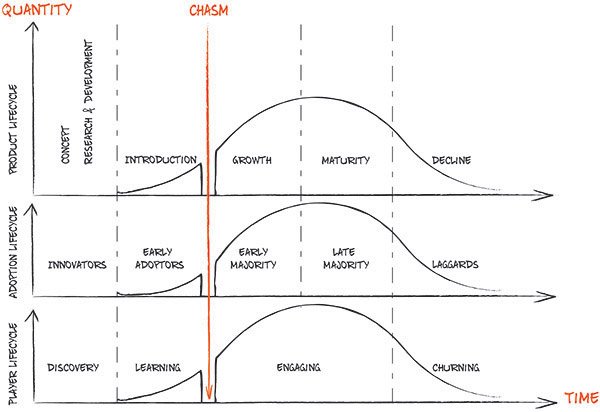
Figure 4.2 The chasm found in product lifecycle, technology adoption, and player lifecycle.
Time to Learn in a Safe Place
The next stage is the learning stage. This is where the player has first downloaded the app and is starting to learn about where, or whether, this game fits into their lifecycle. They are also learning about the flow of the game monetization and whether they can see the value in playing on, as well as how much they might wish to spend. This stage is critical and delicate, especially with the freemium model. At least with a paid-for game we have the motivation to get through the tutorial in order to get to the game experience we paid for. However, freemium games have no such invested value or utility to maximize. This means we have no reason to keep with that game other than our curiosity and expectations of entertainment. Anything that doesn’t support the enjoyment of the player or their expectation of delight will inhibit their engagement. We have very short time to get them into playing and shouldn’t waste that by building in levels of unnecessary menu systems, tutorials or QuickTime videos. If we don’t delight these players the chances are that they will look elsewhere for something to entertain them. This is just the start of the learning process and in later chapters we will go into more detail on how we can evolve the player engagement up to the point where we have built sufficient trust so that they are willing to make the transition to the next stage, “engaging.” The learning process is an important stage if we are to convert a player to become a repeat player or repeat payer; just like with Moore’s “chasm” we have to help the learning player evolve to the point where they treat our game as part of their lifestyle.
Repetition, Repetition, Repetition
Repetition is vital to building habit and commitment to our game. If we can’t create that repetition, we won’t achieve the potential lifetime value which is so vital to the success of games as a service. Repetition is only the start of course as during the “engaging” stage we also want to focus on converting players to start spending money on our game. Only if we have demonstrated the value of investing time into the experience of our game will we be able to provide the conditions where they will be willing to pay. We actively want players to feel committed to continue to play as long and as regularly as they feel the game entertains them before we really start to consider asking them to pay. Some developers have been successful in pushing for earlier revenue, however that is often at the expense of the lifetime value. The better alternative is to realize that it is during this “engaging” stage that our players are most connected with our content. They have taken our game into their lifestyle and will happily repeat that experience over their playing lifetime. They already trust and understand the experience and will return our investment with their time and/or money.
Money For Nothing
One of the hardest things to accept about the Free2Play (F2P) model is that the vast majority of players will never pay. This is difficult for many people to understand. The problem largely comes down to the fact that most us assume that the effort we put in has a direct value. Just because we put hundreds of hours into the creation of a product doesn’t mean our product is “worth” thousands of pounds to the buyer. The product is only worth what the buyer is willing to pay. This can work in our favor too. A product that is cheap to produce but that everyone wants will be highly profitable. I don’t want to go too far into the talk of monetization now, that will be covered later in the book. However, it’s important to think of “engaging” as the most valuable life-stage, even though that’s not just in terms of direct cash. Committed regular non-payers are as important to the success of any game as the highest-spending users. Without them, we don’t create the social context that makes it worthwhile for the high spenders to pay for our game. Additionally, the longer we retain these players the greater the opportunity we will have to eventually convert them.
It Takes 8–12 Days to Engage
During my time at Papaya Mobile we looked at the performance of the best monetizing social mobile games and saw that average a typical high-spending, regularly repeat-playing, “whale” user (which we defined as someone who spent $100+ each month for at least three months) didn’t start spending until after 8–12 days had passed. When you look at the data for your game, can you predict which of your new players are going to become these high spenders? If we can’t engage players for this length of time, or don’t offer enough content, then we are probably missing a highly valuable audience. It’s vital to understand and sustain all the different cohorts (or segments) of your audience and look for the best way to maximize their engagement stage. Freeloader players in particular provide a hugely valuable role in the ongoing discovery of your game as they often share their playing experiences with their friends in person and through social media. Finally, freeloaders who have gone past the learning stages of the game are also generally quite comfortable to see advertising within the game—assuming its placement is appropriate. In particular, they may even readily seek out opt-in incentivized advertising, if available, in order to gain in-game currency in order to further sustain their enjoyment of our game. This is a direct revenue source, but more importantly it extends the retention of that player and teaches them to use the in-game currency earned to learn how to value spending money. Making a great game is about engagement not just monetization, and that also brings acquisition and retention.
Mature Content
The earning stage, like the maturing stage of product lifecycle, is essential to the lifetime profitability of any game. Our objective is to sustain the players in this stage for as long as possible and this takes a great deal of effort and development. We need to consider events and activities, as well as the perpetual addition of new content and appropriate new features. Even simple download games feel “dead” if the app hasn’t been updated in several weeks, services need to feel alive every day—ideally more frequently. At 3UK we discovered that the average frequency of return to the game store was directly related to how frequently we updated the site. In the end we managed to find a way to update the front page every four hours, significantly increasing our sales. The same affect can be seen in games as services.
Plan for Change
Obviously, with the technical constraints as well as the various platform processes, it’s not practical to create a pipeline of new activity to constantly update the experience with new material; that would be both costly and a huge resource commitment. However, it is possible to make the game feel like it constantly changes with a few simple preprogrammed changes. In order to build and reinforce habits, it’s useful to consider how you can create regular predictable changes that build delight and then complement these with apparently random moments of irregular rewards, ideally within the context of the game narrative.
All Things Come to an End
However, this won’t continue forever. In time players will leave the service, we tend to call this “churning.” Managing churning users is just as important as any other part of the lifecycle. We want the best possible outcome for our players, not least as we need to be able to plan our resource commitments and still be able to sustain any remaining players as long as practical. Additionally, if players are content with their experience playing our games, we have a greater chance to bring them back to play other games we make, perhaps even creating a level of anticipation that would otherwise be expensive to reproduce. Also if we manage their departure, we have more chance to turn this into an opportunity for additional revenue through advertising or, better still, convert this into new users through cross-promotion. Ideally, churning players will continue to recommend our game to their friends. If on the other hand we leave players feeling exploited or that we have squeezed every penny out of them they will tell other people about their bad experience. That negative feedback is poisonous (assuming we want to have a long career making games) and players are vastly more inclined to tell people of a bad experience rather than a good experience. This is essentially the same effect that comes from relying too heavily on “Skinner Box”-style techniques; players feel exploited if they feel they continued playing longer than was “good” for them.
The Soul of a Service
Thinking of a game as an organism means we have to take into account the different life stages. These aren’t just convenient distinctions to help us think about the strategy of development but also help us in terms of thinking about the evolution of the type of entertainment that those players want to experience over time. It allows us to think of the game as a living, evolving thing that needs sustainable conditions if it is going to survive and thrive. Using the perspective of the player lifecycle from discovering, learning, engaging and churning helps us to apply a different mindset to each stage of the player’s experience. It requires us to accept that a player’s needs will change over time as their relationship with the game changes and that we have to adjust our approach if we wish to retain them as their engagement evolves. These are factors that we need to take into account not only in the design of the ongoing support of the game, but also in terms of the design of the playing experience itself; especially in terms of the context and metagame aspects of game design.
More than that as we launch our game we will find that it will have to adapt to its surroundings and we will see it change as we adjust the parameters, hone the mechanics, reward systems, and success criteria. Watching the player lifecycle allows us to evolve the game in line with the needs of our players. It’s the soul5 of games as a service.
Notes
1 Technically the introduction of all new products using the same brand is a “brand extension” or “line extension.” If you want to investigate this further, it’s worth checking out works such as Strategic Brand Management: Building, Measuring, and Managing Brand Equity by K.L. Keller.
2 Geoffrey Moore’s Crossing the Chasm: Marketing and Selling High Tech Products To Mainstream Customers was initially released in 1991 and remains one of the most influential studies on entrepreneurial marketing. It is one of the few marketing principles I have continually relied on throughout my marketing career, not just in games.
3 3UK is shorthand for the UK Mobile Phone Operator Three, part of the Hutchison Whampoa group. I was responsible for the games offering there between 2001 and 2006. There were a lot of firsts which we were able to do during my time there from the first mobile in-app purchase solution (Rent Games), first 3G realtime multiplayer games (a FPS called Lock’n’Load) as well as the first Video game reviews channel on mobile.
4 Wireplay was an online gaming service using dial-up modem based connectivity. The project led by Colin Duffy and Richard Warren came out of British Telecom’s experiments with video on-demand based in Milton Keynes in the UK. It missed being the world’s first such service by just two weeks when MPlayer launched in the USA.
5 As an atheist it’s hard to come up with a good definition of a soul, but for me it’s a way of looking at a thing as a whole, rather than just the sum of its parts. I use it here because it allows me to propose a difference between the lifecycle and the metagame. The meta�game allows us to consider the role of the environment from within the context of the experience, hence my analogy with the psychology of the game. The lifecycle is a different kind of design influence. It’s about the players’ engagement and how the relationship evolves over time.
Exercise 4: What is the Context Loop?
Following on from Exercise 3, where we looked at the mechanic loop, in this exercise we are going to focus on the context loop. This allows us to think about how we are going to sustain our audience over the longer term and how we give them purpose and progression. To do this well we should try to understand the changing needs of the player and to find ways to encourage them to become even deeper involved with the game experience. The purpose of the context loop is to sustain the life of the game over time, creating reasons for the player to continue to want to return and engage. Ideally we will create a positive form of the “CrackBerry” effect, where players feel that they might be missing out when they aren’t playing the game (for more on this, see Chapter 5).
To help us with this process let’s use a cut-down version of the hero’s journey1 as a tool to model the essential aspects of a narrative model. The first stage is the “call to adventure.” In this situation it’s about how we draw the player into our game and how we explain the mechanics of play and excite them about the possibilities of the game. There is an argument that at each new tier of the game we should introduce new playing methods, renewing the call and reinvigorating the player.
The next stage is the “awareness of challenge.” In our case this is about how we introduce the player to new variations and increasing complexity. This is still a handholding process and may include the support of a “mentor” figure if that proves useful. This process doesn’t have to lead the player by the nose with a step-by-step path, we can use alternative missions, side quests, even a complete narrative sandbox to play in. But we still want a sense of purpose and progression.
After that the progression commences in earnest and we have a series of “challenges and improvements,” which allow us to trace the player’s progression and the rate at which they approach the “boss level.” That approach should be designed to draw the player ever closer to that larger goal with the knowledge that it will be truly challenging, but with the greatest reward. We need to understand whether our context loop approach will directly signpost the boss level, or if instead we build up the suspense and simply foreshadow the inevitable showdown. The term “boss” is intentionally derivative, there may be no traditional enemies or bosses to beat, indeed the idea of a “level” might have no direct relevance, but that doesn’t mean we don’t need narrative tension and you should consider this whatever the equivalent for your game. The final stage is the “transformation” of your character, which takes them up to the next tier of engagement. There may be new goals, new abilities and new narrative arcs to follow, but we should relish the moment of triumph after the boss level before moving onto the next step in the narrative.
As I continue to stress it’s vital that we consider the replayability2 of your game. I don’t mean just is it possible to repeatable the experience. I choose to define that term in a way where I mean that each return to the experience feels like a new game session. Repetition is dull and lifeless, replay value brings something fresh each time the game is played.
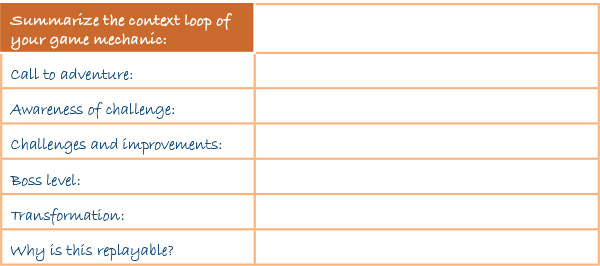
Mapping out the stages is just the start of course and we have to think about how we will in practice deliver our context loops.
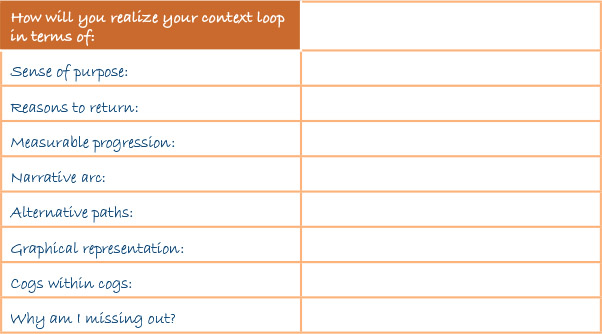
Worked Example:
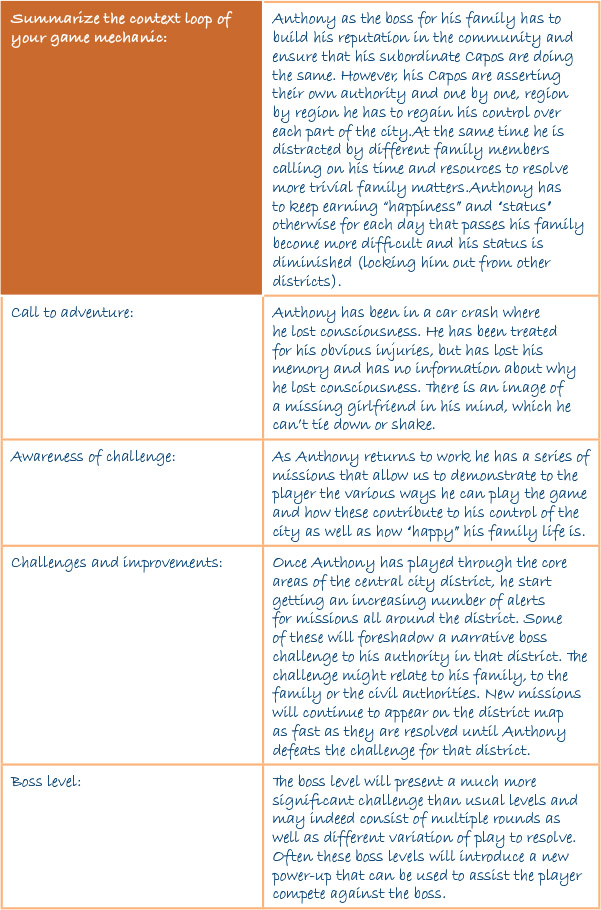
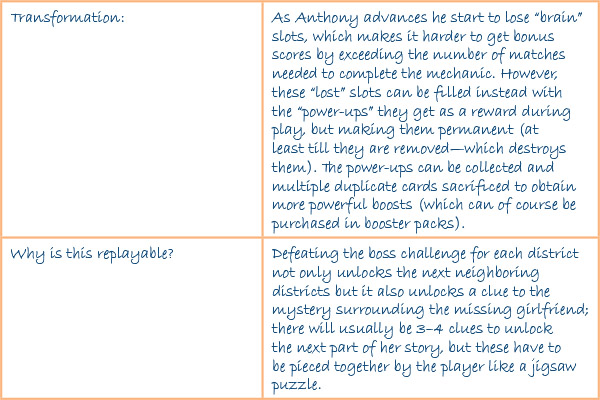
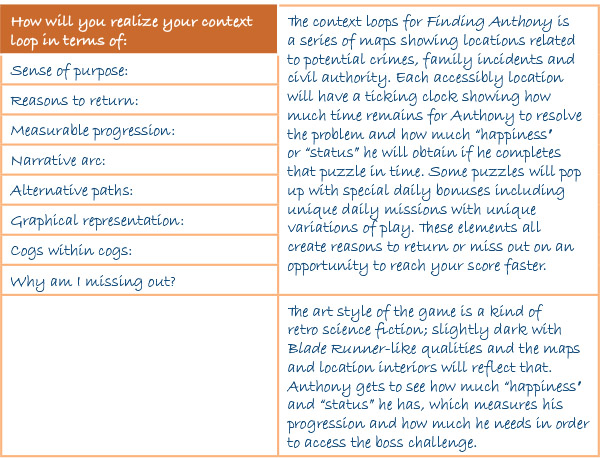

Notes
1 The hero’s journey is a tool widely used by writers as a template for the progression of their characters through their stories. It’s a deceit on the principle of the monomyth, the idea that all heroic stories are essentially variations of the same story, http://en.wikipedia.org/wiki/Monomyth.
2 Not everyone likes the word “replayability,” http://iam.benabraham.net/2010/09/replayability-is-not-a-word.
